Physical Address
304 North Cardinal St.
Dorchester Center, MA 02124
There is no more potent a motive in life than to preserve the integrity of the self. Our existence as autonomous agents rests on the ability to detect a multiplicity of dangers and threats and respond to them both expediently and effectively. The most important signaling mechanism for imminent harm is the pain system, and it is unsurprising that the quintessential aversive nature of pain serves as a metaphor for non-nociceptive ill feelings. This speaks to the core phenomenological status of pain as providing the most potent signal of imminent harm. Underlying this emotional content are two central properties: conscious perception of unpleasantness and induction of behavior that serves to terminate current and minimize future painful occurrences.
Despite impressive progress in understanding the peripheral and spinal mechanisms of nociception ( , , ), we know relatively little about how the brain uses this input to give rise to pain perception and behavior. A systems-level account of pain behavior demands an understanding that spans three distinct levels ( ) ( Fig. 17-1 ). The first level identifies the specific nature of the problems facing an organism that are ultimately solved by having a pain system. The second level deals with how these problems are solved at a theoretical level. The third level concerns how these solutions are implemented in the brain. Ultimately, the phenomenology of pain arises from processes that subsume all three levels.
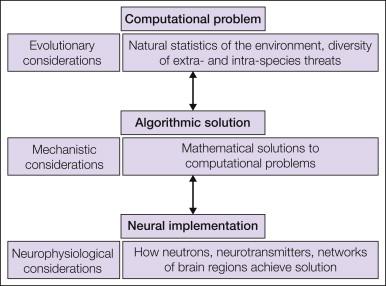
The principal function of the pain system is to minimize tissue damage. The breadth of the subjective components of pain, in terms of the perceptual, cognitive, and affective processes evoked, reflects a coordinated engagement of multiple systems. Furthermore, different types of injury and different environmental and physiological contexts can have very different manifestations on behavior ( , , , , ), thus revealing a complexity of levels that argues against any simple, unified model of pain. However, there are undoubtedly core processes that span the diversity of pain experiences, and we focus on this aspect in this chapter.
First we describe how pain perception can be viewed as a problem of inference about the causes of a potentially harmful event. We then describe how motivational value is a key component of this process and how it incorporates not just pain itself but equally the prediction of pain. We discuss how pain and pain prediction lead to an additional set of motivational states related to relief and discuss opponent models of motivation. Next, we illustrate how motivational learning can be used to drive decision making by outlining how innate, habit-like, and goal-directed decision-making systems underlie three distinct value and decision-making systems in the brain. Finally, we adopt a behavioral economic perspective and discuss insights into pain that stem from an axiomatic approach to choice.
The perception of both pain intensity and pain aversiveness is not a simple feedforward process that reads out the amplitude of an ascending nociceptive signal to evoke a conscious unpleasant sensation ( ). A wide variety of factors influence perception, including expectation, uncertainty, multisensory input, behavioral and environmental context, emotional and motivational state, self versus externally induced pain, and controllability ( , , , , , , ). This illustrates the complex process by which the brain constructs the sensory and emotional sensation of pain and challenges any standard “perception–action” model.
The best-studied contribution to perception comes from expectation, not the least since this lies at the heart of the placebo and nocebo analgesic effect ( ). In brief, expectation generally biases perception in the direction of that expectation: if one expects a higher degree of pain than is inflicted, the pain is typically felt as more painful. An expectation of mild or no pain similarly reduces actual pain. The source of information from which an expectation is derived is diverse and ranges from the implicit information inherent in pavlovian conditioning to explicitly provided verbal instruction, and a multitude of experimental manipulations attest to the ubiquity and complexity of these effects and their biological correlates ( , , , ).
Underneath this apparent complexity may lie a relatively simple model, which we propose here. An expectation can be considered as a belief, and this in turn can be formalized as a probability distribution over possible intensities of pain ( Fig. 17-2 A). In the simplest case, this could be a prediction about the intensity of pain at a given point in time. Accordingly, the belief distribution incorporates the full breadth of an expectation with a mean intensity and uncertainty.
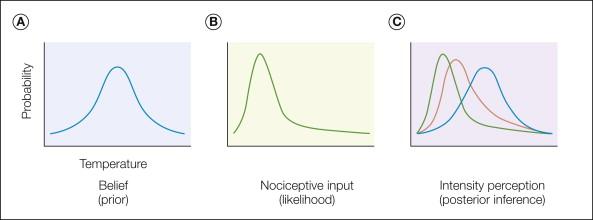
The relevance of this distribution comes from how this information is integrated with pain itself, although the exact nature of this integration has yet to be determined precisely. Possibly the most plausible way is to consider the effects of pain expectancy on a par with the effects of expectancy in other sensory modalities (e.g., , ), which consider the incoming sensory input as a probability distribution (in a similar fashion to expectancy) ( Fig. 17-2 B). In this manner, pain perception becomes a problem of inference in which one tries to infer the most likely intensity of an external nociceptive event given two sources of information, each with their own uncertainty. From a statistical perspective, the optimal way to make this inference is to use the Bayes rule, which simply involves multiplying (and normalizing) the two distributions ( Fig. 17-2 C). This accounts for the observation that more certain expectancies (i.e., more narrow distributions) appear to exert a stronger influence on subsequent pain ( ).
There is one further important component of pain perception that underlies the well-described distinction between the sensory perception of intensity and the emotional perception of unpleasantness. Whereas perception of intensity can be thought of as representing an accurate statistical estimate of the nature of the pain, the perception of unpleasantness incorporates the overall motivational significance of that pain to the individual. In this way it is clear that the same pain can have very different motivational significance in different physiological, behavioral, and environmental contexts. This can be illustrated in an experimental procedure called “counter-conditioning”—a pavlovian paradigm in which a painful stimulus repeatedly precedes a pleasant reward of some sort ( ; ) ( Fig. 17-3 ). As an individual learns the association between the pain and the reward, the aversiveness of the pain is diminished despite an apparently intact ability to appreciate the intensity of the pain. Indeed, this phenomena has sometimes been used as a psychological strategy in the clinical management of pain ( , ).
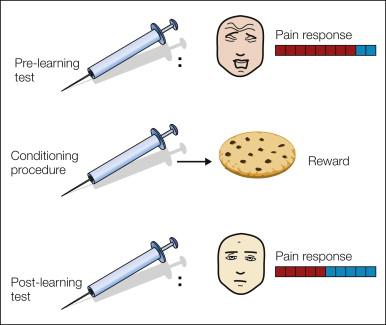
The concepts of motivational value and utility lie at the heart of emotional accounts of pain. In economic theories of value (discussed in more depth below), the overall expected value of an event is equal to the mean of the product of the probability and value. Thus, since the value function is monotonically increasing (more pain is always worse than less pain), perceptual uncertainty about pain should exert a more dominant effect when above, as opposed to when below, a mean expectation. Although behavioral data suggest that this may well be the case ( , ), well-designed studies manipulating the statistics of expectancy and painful stimulation are lacking.
Even though simple expectancy phenomena may exert an influence on pain affect, it seems unlikely that this explains other instances of modulation ( , , , , , ). In particular, pain modulation often displays a sensitivity to behavioral context beyond that which an account based on the mean motivational value of pain can explain. Instead, modulation appears to be the result of a “decision” by the pain system ( ) (e.g., by reducing ascending nociceptive input), which necessitates an account of how motivation and value relate to decision making.
The concept of value captures the implications that a painful episode has on the overall welfare of the individual. In principle, value can be defined on a transitive scale of preferences: pain A has a smaller aversive value than pain B if it is consistently preferred in a forced choice between the two. A dominant approach to understanding motivation in animals and humans has been study of the acquisition of value by events that predict an event of intrinsic value (such as pain). Thus not only does pain itself have aversive value, but so also do events that predict its probable occurrence; when fully predicted in this way, pain merely fulfills its expectation. The core mechanisms of prediction have been studied for decades via pavlovian conditioning, which despite its apparent simplicity, betrays a complex and critically important set of processes that lie at the heart of animal and human motivation ( ) ( Fig. 17-4 ).
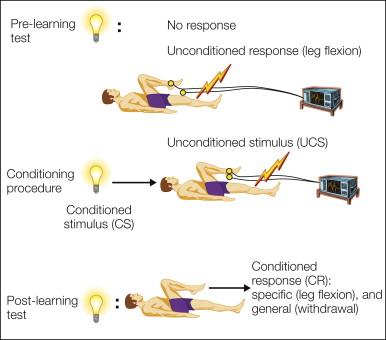
The conditioned response has two important properties. First, it is not merely a copy of the unconditioned response (stimulus substitution) but is appropriate to anticipation of the painful event. Second, it is not unitary in nature but consists of stimulus-specific and general affective components. Stimulus-specific responses reflect the precise nature of the pain being anticipated (e.g., leg flexion in anticipation of foot shock or eye blink in response to a puff of air onto the eye); general responses are specific only to valence and are shared across predictions for any aversive outcome, with the key example being a withdrawal response. Such general aversive responses seem to betray a unitary underlying aversive motivational system, and ingenious experimental designs such as trans-reinforcer blocking provide good evidence of this concept (see ).
One of the challenges in the study of pavlovian motivation is to understand how value is acquired. The importance of statistical contingency is illustrated by the fact that increasing magnitude, probability, and temporal proximity of a painful stimulus increase the magnitude of the pavlovian value ( ). Furthermore, it is known that learning depends on a prediction error—the difference between the expected and actual value of an outcome. Thus, if an outcome is worse (more painful) than expected, the aversive value of the preceding cue increases, and if it is better than expected, the aversive cue value diminishes. This is captured within reinforcement learning models of pain conditioning ( , ), which describe in algorithmic terms what quantities the brain uses in constructing representations of aversive motivational value. Reinforcement learning models are similar to the well-known error-based learning rule but extend them to real-time learning in which pavlovian cues can transfer value to each other when chains of them occur in sequential relationships ( ) ( Fig. 17-5 ).
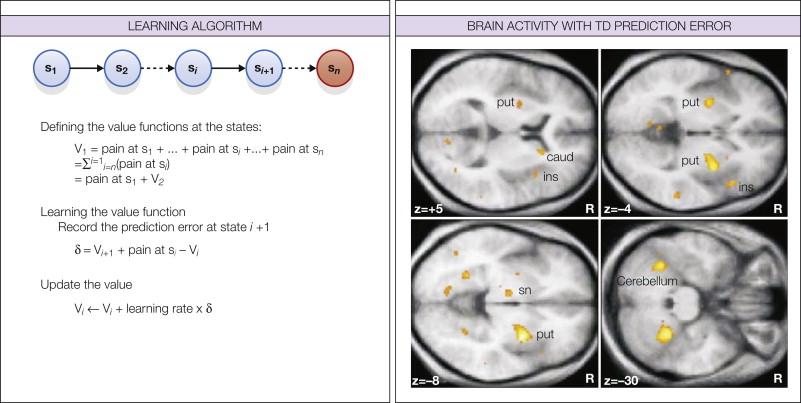
In the example below, consider a sequence of states that end in a terminal state in which pain is experienced. The goal of learning is to predict the value of the pain expected to occur if one finds oneself at state 1 (i.e., to learn to make predictions as early as possible). Early in learning, the states immediately preceding the terminal pain state acquire aversive value, but with more experience, the value is transferred backward to earlier states. Beyond this simple example, the value-learning process can easily be modified to incorporate discounting of future options and probabilistic state transitions ( , ).
Become a Clinical Tree membership for Full access and enjoy Unlimited articles
If you are a member. Log in here